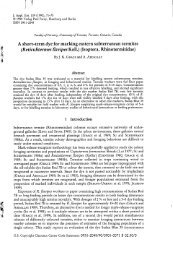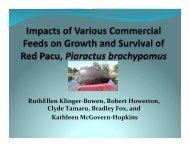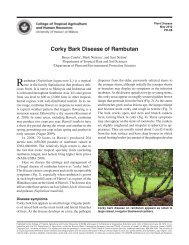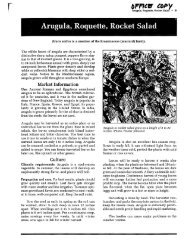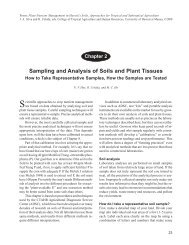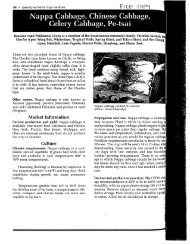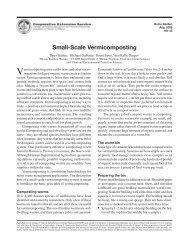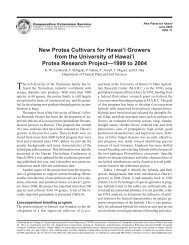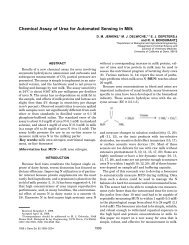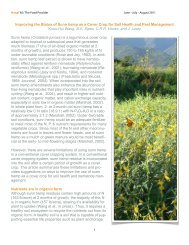Macadamia Nuts in Hawaii: History and Production - ctahr ...
Macadamia Nuts in Hawaii: History and Production - ctahr ...
Macadamia Nuts in Hawaii: History and Production - ctahr ...
Create successful ePaper yourself
Turn your PDF publications into a flip-book with our unique Google optimized e-Paper software.
Table 2. M<strong>in</strong>imum temperature regimes of areas <strong>in</strong> <strong>Hawaii</strong>, Australia, <strong>and</strong> California<br />
Area Average m<strong>in</strong>imum temperature °C (OF) Remarks<br />
<strong>Hawaii</strong><br />
Ka<strong>in</strong>aliu<br />
Waiakea<br />
Pahala<br />
Kalopa<br />
Hamakua<br />
Mealani<br />
Kamuela<br />
December<br />
13.9(57)<br />
17.2(63)<br />
17.2(63)<br />
12.8(55)<br />
12.8(55)<br />
10.6(51 )<br />
12.2(54)<br />
January<br />
14.4(58)<br />
15.5(60)<br />
17.8(64)<br />
11.7(53)<br />
I I.I(52)<br />
8.3(47)<br />
1l.! (52)<br />
February<br />
13.9(57)<br />
15.8(60)<br />
17.8(64)<br />
11.8(53)<br />
I l.!(52)<br />
10.0(50)<br />
11.7(53)<br />
Excellent<br />
"<br />
"<br />
Poor La bad<br />
"<br />
"<br />
"<br />
Australia<br />
AlSLanville (Lismore)<br />
Nambour<br />
B<strong>and</strong>aberg<br />
Atherton Table L<strong>and</strong><br />
Bowen<br />
Townsville<br />
Ingham<br />
Innisfal<br />
Cairns<br />
June<br />
10.3(51 )<br />
8.0(46)<br />
11.9(53)<br />
10.6(51 )<br />
15.7(60)<br />
14.2(58)<br />
13.9(57)<br />
15.8(60)<br />
17.6(64)<br />
July<br />
9.2(49)<br />
6.4(44)<br />
10.3(51)<br />
9.5(49)<br />
15.0(59)<br />
13.4(56)<br />
13.0(56)<br />
14.8(59)<br />
17.0(63)<br />
August<br />
9.9(50)<br />
7.2(45)<br />
11.4(53)<br />
10.4(51)<br />
16.1(61)<br />
14.4(58)<br />
13.8(57)<br />
15.0(59)<br />
17.4(63)<br />
September<br />
11.7(52)<br />
9.7(49)<br />
13.9(57)<br />
12.1(52)<br />
18.2(65)<br />
17.1 (63)<br />
15.1(59)<br />
16.5(62)<br />
18.6(66)<br />
Bad; too cold<br />
"<br />
"<br />
"<br />
Should be good<br />
"<br />
"<br />
"<br />
"<br />
California December January February<br />
Vista 1.7(35) 1.7(35) 2.2(36) Subtropical temperature<br />
Escondido I.I(34) 3.9(39) 3.3(38) "<br />
Exam<strong>in</strong>ation of Table 2 <strong>and</strong> Nakata's raceme<br />
count <strong>in</strong> Fig. 29 <strong>in</strong>dicates that the temperature<br />
regimes of Waiakea <strong>and</strong> Pahala, with their high<br />
yield of 6000 pounds per acre, are closerto Nakata's<br />
best treatment at 18°C. Ka<strong>in</strong>aliu is slightly lower<br />
<strong>in</strong> temperature than Waiakea or Pahala, but a<br />
temperature reversal pattern obta<strong>in</strong>ed here results<br />
<strong>in</strong> a dry flower<strong>in</strong>g season with hardly any blossom<br />
blight diseases, allow<strong>in</strong>g nut set to be excellent.<br />
On the other h<strong>and</strong>, Kalopa <strong>and</strong> Hamakua are at<br />
Nakata's 12°C, <strong>and</strong> yields are about 2000 to 3000<br />
pounds of nuts per acre. Whatever trees are<br />
grow<strong>in</strong>g <strong>in</strong> the Mealani area are bear<strong>in</strong>g very<br />
sparsely; however, the tetraphyllas planted at<br />
Kamuela are thriv<strong>in</strong>g.<br />
The m<strong>in</strong>imum temperature regimes of the<br />
Australian areas now <strong>in</strong> macadamia production<br />
(Table 2) are quite similar to, or lower than, those<br />
obta<strong>in</strong>ed at Hamakua <strong>and</strong> Kamuela. In fact, the<br />
temperatures from Alstonville to the Atherton<br />
Table L<strong>and</strong> more closely resemble those obta<strong>in</strong>ed<br />
at Mealani, which is cold <strong>and</strong> wet, <strong>and</strong><br />
where the <strong>in</strong>tegrifolias do not yield.<br />
The m<strong>in</strong>imum temperature is probably the<br />
ma<strong>in</strong> cause of the poor yield-both at the higher<br />
elevations <strong>in</strong> <strong>Hawaii</strong> <strong>and</strong> <strong>in</strong> the Australia macadamIa<br />
areas. These areas <strong>in</strong> Australia yield only<br />
28<br />
about half of tha t obta<strong>in</strong>ed <strong>in</strong> the tropical zones <strong>in</strong><br />
<strong>Hawaii</strong>. The suggestion is made here that macadamia<br />
should not be planted much beyond 1500<br />
feet <strong>in</strong> elevation <strong>in</strong> <strong>Hawaii</strong>. Perhaps <strong>in</strong> Australia<br />
the macadamia nuts would do better on the lowl<strong>and</strong>s<br />
between Bowen <strong>and</strong> Cairns, which have<br />
temperatures comparable to <strong>Hawaii</strong>'s tropics.<br />
California, on the other h<strong>and</strong>, gave up on the<br />
<strong>in</strong>tegrifolia a long time ago, <strong>and</strong> plants only the<br />
tetraphyllas. Allen (1), work<strong>in</strong>g on photosynthesis<br />
<strong>and</strong> heat stress of tropical plants <strong>in</strong> South Africa,<br />
suggested the temperature range between 16° <strong>and</strong><br />
25°C as best for photosynthesis <strong>in</strong> macadamia. In a<br />
gross sense, his f<strong>in</strong>d<strong>in</strong>gs support our belief that<br />
12°C dur<strong>in</strong>g the flower<strong>in</strong>g season may be too cold.<br />
These temperature analyses <strong>and</strong> yield performances<br />
from the fields <strong>in</strong> <strong>Hawaii</strong> seem to <strong>in</strong>dicate<br />
that Nakata's growth room f<strong>in</strong>d<strong>in</strong>gs are real <strong>and</strong><br />
reliable. Until better records are experimentally<br />
produced, the m<strong>in</strong>imum temperature regime concept<br />
presented here should be used to help <strong>in</strong> the<br />
production of macadamia nuts.<br />
Categorically, the macadamia nut tree can be<br />
economically grown atelevations <strong>in</strong> <strong>Hawaii</strong> where<br />
p<strong>in</strong>eapple, guava, coffee, papaya, mango, <strong>and</strong><br />
banana are profitably grown. Except for a few<br />
areas with def<strong>in</strong>ite southern exposure, most of the



